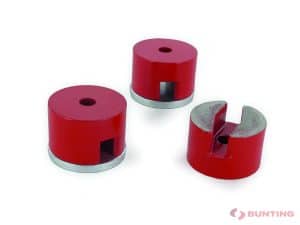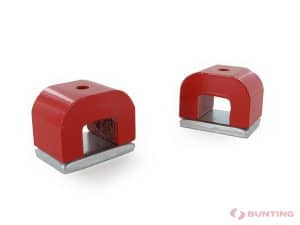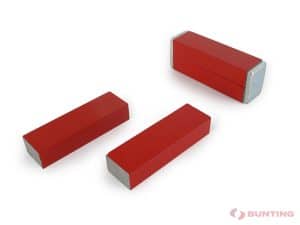No products in the basket.
Alnico Magnets
e-Magnets offer an extensive range of traditional Alnico Magnets in all the common shapes including Horseshoe, Button, Deep Pot, Limpet Pot and Bar Magnets. Alnico offers outstanding temperature stability, it can be used in high temperature applications and has a high resistance to corrosion.
Buy Alnico Magnets online with e-Magnets™
Alnico magnets are produced by either a sintering method or, more commonly, a casting method. Alnico is an alloy containing Aluminium, Nickel, Cobalt, Iron and Copper. It is a hard yet brittle magnet which is very difficult to machine or drill and is not recommended for structural use. The as cast or as sintered shape is acceptable for many applications but surfaces may be precision ground for a smoother surface finish with tighter tolerances although this will increase cost. As the magnets are sintered or cast, small quantity production runs are generally not possible or, if done, may contain significant tooling charges and minimum quantity requests (casting requires sand molds to be made, sintering requires die presses to be made). The standard grade is Alnico 5 although other grades are available which we can offer as part of our bespoke magnet service. Cast Alnico magnets may have very small air holes in their structure – this is normal and cannot be avoided. Sintered Alnico magnets do not have holes in the structure.
Although not always regarded as necessary because of their high resistance to corrosion, the Alnico magnets are sometimes given a protective coating or even simply a coating to make the magnet more aesthetically pleasing. The colour of the coating is almost always red. This gives us the Alnico Red Magnet range.
Alnico magnets have very high Br values, comparable with the NdFeB and SmCo magnets. They have an advantage in that they can be cast into complex shapes and can be magnetised during the heat treatment stages required to give Alnico its final magnetic properties. The magnets are often magnetised in the final assembly to give the best performance (where magnetising is possible). This allows more complex magnetising patterns such as the Horseshoe magnet shape to be possible.
Alnico magnets are still used in loudspeakers, dc motors, generators, sensors, magnetic separation equipment, Hall-effect devices, TWT, magnetrons, electricity meters, cow magnets, etc. If the application requires any of least change in output with temperature variation, high field output, or very high temperature operation, then Alnico may be very suitable.
Alnico does has a low coercive force. This means that it is easily demagnetized by external demagnetising fields. It is therefore possible to magnetise the magnet when part of an assembly (providing the means to magnetise is possible). The Alnico may also self demagnetize. This depends on the total magnetic circuit but an example may be removing an Alnico magnet from a motor assembly for inspection and then placing it back and discovering the magnetic output has fallen. Putting the Alnico magnet in open circuit may be enough to cause self demagnetisation (the working point is taken beyond the ‘knee’ of the Intrinsic curve, causing demagnetisation). The working point is changed if the magnetic circuit changes. Self demagnetisation occurs because the magnetic field from the magnet can pass back through the magnet itself (the magnetic path is more preferable than the air surrounding the magnet), which is thus an external demagnetising field applied by the magnet itself (all magnets in free space will apply a self–demagnetising field but only magnets with very low working point and/or a low Hci values will show demagnetisation as a result of it). Rare Earth magnets (NdFeB and SmCo) and ferrite magnets, in normal operation, do not demagnetise by self demagnetisation. Alnico (and indeed all magnets) is better at resisting self demagnetisation by being longer in the direction of magnetisation than in the other dimensions (usually termed Length to Diameter, L/D, ratio) as this increases the working point on the Intrinsic curve. An L/D ratio of at least 4 or 5 is considered a better design for Alnico. This is why Alnico magnets are very rarely short in length. For note, most BH curves for Alnico show a single curve, often the Normal curve. This is because the Intrinsic curve is deemed to be similar to the Normal curve but, to be accurate, the Intrinsic curve is the only curve to be used to determine demagnetisation effects (you may be able to use the Normal curve for crude analysis on Alnico but use of the Normal curve with any other magnet material will give incorrect results).
Alnico magnets offer outstanding temperature stability. The output from Alnico magnets varies the least with changes in temperature, making it an ideal choice for temperature sensitive applications. The reversible temperature coefficient of induction is -0.02%/deg C from ambient and the reversible temperature coefficient of Intrinsic Coercivity is +0.01%/deg C from ambient.
It is generally recommended not to use Alnico magnets at temperature above 500 deg C. Alnico magnets are the only real choice for temperatures above 350 deg C as the Samarium in SmCo Rare Earth magnets migrates out of the structure above 350 deg C causing permanent loss in magnetic output. -75 deg C is regarded as a reasonably acceptable lower temperature for using Alnico although irreversible losses of around 10% are reported at -190 deg C. The actual losses for Alnico are a function of the magnet geometry, total magnetic circuit and the BH curve shape.
Alnico can be supplied in varying grades and various sizes. If a particular BH curve for Alnico is required (or special Br, Hc and Hci values are required), it may be possible to manufacture (or we may be able to suggest a near alternative) because the properties can be varied during casting and heat treatment although such magnets may be more costly to produce and may require minimum order quantities.
Why choose us?
• 99% of orders delivered within 24 hours
• Over 1,500,000 magnets in stock
• More than 60 years experience







